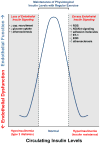Exercise-induced Signals for Vascular Endothelial Adaptations: Implications for Cardiovascular Disease
- PMID: 22844545
- PMCID: PMC3404842
- DOI: 10.1007/s12170-012-0241-5
Exercise-induced Signals for Vascular Endothelial Adaptations: Implications for Cardiovascular Disease
Abstract
This article reviews recent advances in our understanding of hemodynamic signals, external/compressive forces, and circulating factors that mediate exercise training-induced vascular adaptations, with particular attention to the roles of these signals in prevention and treatment of endothelial dysfunction and cardiovascular (CV) diseases.
Conflict of interest statement
Figures



Similar articles
-
Vascular nitric oxide and oxidative stress: determinants of endothelial adaptations to cardiovascular disease and to physical activity.Can J Appl Physiol. 2005 Aug;30(4):442-74. doi: 10.1139/h05-133. Can J Appl Physiol. 2005. PMID: 16258183 Review.
-
Exercise-mediated adaptations in vascular function and structure: Beneficial effects in coronary artery disease.World J Cardiol. 2021 Sep 26;13(9):399-415. doi: 10.4330/wjc.v13.i9.399. World J Cardiol. 2021. PMID: 34621486 Free PMC article. Review.
-
Regulation of coronary blood flow during exercise.Physiol Rev. 2008 Jul;88(3):1009-86. doi: 10.1152/physrev.00045.2006. Physiol Rev. 2008. PMID: 18626066 Review.
-
Hemodynamic and vascular effects of resistance training: implications for cardiovascular disease.Arq Bras Cardiol. 2007 Oct;89(4):256-62. doi: 10.1590/s0066-782x2007001600008. Arq Bras Cardiol. 2007. PMID: 17992383 Review. English, Portuguese.
-
Vascular Adaptation to Exercise in Humans: Role of Hemodynamic Stimuli.Physiol Rev. 2017 Apr;97(2):495-528. doi: 10.1152/physrev.00014.2016. Physiol Rev. 2017. PMID: 28151424 Free PMC article. Review.
Cited by
-
Medical management of stable coronary atherosclerosis.Curr Atheroscler Rep. 2013 Apr;15(4):313. doi: 10.1007/s11883-013-0313-0. Curr Atheroscler Rep. 2013. PMID: 23423522 Review.
-
Potential Diagnostic and Prognostic Biomarkers of Epigenetic Drift within the Cardiovascular Compartment.Biomed Res Int. 2016;2016:2465763. doi: 10.1155/2016/2465763. Epub 2016 Jan 28. Biomed Res Int. 2016. PMID: 26942189 Free PMC article. Review.
-
State of Knowledge on Molecular Adaptations to Exercise in Humans: Historical Perspectives and Future Directions.Compr Physiol. 2022 Mar 9;12(2):3193-3279. doi: 10.1002/cphy.c200033. Compr Physiol. 2022. PMID: 35578962 Free PMC article.
-
Global scientific trends in research of epigenetic response to exercise: A bibliometric analysis.Heliyon. 2024 Feb 6;10(4):e25644. doi: 10.1016/j.heliyon.2024.e25644. eCollection 2024 Feb 29. Heliyon. 2024. PMID: 38370173 Free PMC article. Review.
-
Exercise: putting action into our epigenome.Sports Med. 2014 Feb;44(2):189-209. doi: 10.1007/s40279-013-0114-1. Sports Med. 2014. PMID: 24163284 Review.
References
-
- Blair SN, Kohl HW, 3rd, Paffenbarger RS, Jr, Clark DG, Cooper KH, Gibbons LW. Physical fitness and all-cause mortality. A prospective study of healthy men and women. JAMA. 1989;262:2395–401. - PubMed
-
- Lees SJ, Booth FW. Sedentary death syndrome. Can J Appl Physiol. 2004;29:447. - PubMed
-
- Green DJ, Walsh JH, Maiorana A, Best MJ, Taylor RR, O’Driscoll JG. Exercise-induced improvement in endothelial dysfunction is not mediated by changes in CV risk factors: pooled analysis of diverse patient populations. Am J Physiol Heart Circ Physiol. 2003;285:H2679–87. - PubMed
Grants and funding
LinkOut - more resources
Full Text Sources
